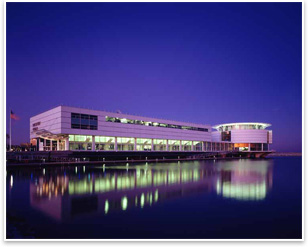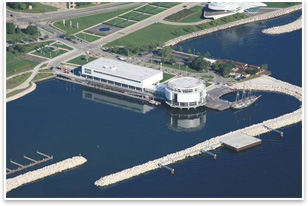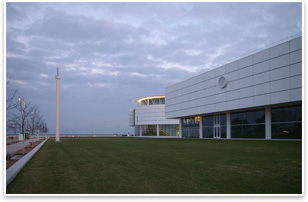Milwaukee’s Lakefront Accessible Once Again
HGA’s Discovery World at Pier Wisconsin opens access to the lake and complements MAM
by Heather Livingston
Contributing Editor
 Summary: The layout of downtown Milwaukee has kept Lake Michigan at arm’s length from Milwaukeeans for too many years. With the creation of Discovery World at Pier Wisconsin, a youth-focused science education center, that’s beginning to change. Summary: The layout of downtown Milwaukee has kept Lake Michigan at arm’s length from Milwaukeeans for too many years. With the creation of Discovery World at Pier Wisconsin, a youth-focused science education center, that’s beginning to change.
Sited on a peninsula adjacent to Eero Saarinen’s 1957 Milwaukee Art Museum and Santiago Calatrava’s 2001 MAM extension, Discovery World at Pier Wisconsin is remarkable not only because its design is complementary to such lauded architectural treasures, but because it provides rare pedestrian access to the lake. James Shields, AIA, project manager, Hammel, Green and Abrahamson, Inc. (HGA) Architects and Engineers, a lifetime resident of Milwaukee, says that it was critical that his design made Lake Michigan easily accessible to downtown, something that hasn’t been available during his lifetime.
 Feats of engineering Feats of engineering
Discovery World at Pier Wisconsin was built on land that formerly housed a dock and parking lots for the car ferry across Lake Michigan to Michigan. Because of its proximity to the water, there were significant engineering obstacles to hurdle. After the site’s existing structures were removed, HGA’s engineers designed a bracing apparatus that, in combination with a water-pumping system, kept Lake Michigan from filling in the foundations dug for the new building’s supports and underwater aquariums. Steel-pipe piles filled with concrete containing nearly 40-percent fly ash and slag pellets from power-plant and industrial waste were sunk into the lakebed. Four piles were secured for each of the 11 columns that hold up the building and keep it from lifting during wave impact or higher lake levels, explains Gordon Pierce, HGA engineer. To create the underwater aquariums, a mud-slab “tub” was solidified with layers of concrete and waterproofing.
 Engaging the public and nature Engaging the public and nature
Measuring 120,000 square feet, the $42 million science education center is composed of two structures linked by a glass-walled concourse that offers continuous views of the lake. The rectangular 72,000-square-foot Discovery World science building houses classrooms and labs, exhibition space, a museum shop, a café, ticketing spaces, and offices. The second structure is the circular 45,000-square-foot Pier Wisconsin building, which provides panoramic views of Lake Michigan from its glass-walled interior and outdoor terrace that hovers above the water. Pier Wisconsin also houses the facility’s saltwater and freshwater aquariums, a digital theater, and event and exhibition space. The 3,000-square-foot glass concourse connects the two structures and functions as a breezeway. Inside the Discovery World building, the concourse’s 40-foot-wide glass panels open directly onto the boardwalk, “creating a major circulation space right on the water that allows visitors to engage the lake with a newfound intimacy,” says Shields.
 A boardwalk of certified, sustainable Ipe wood encircles the structure and provides a path where residents and visitors can walk, run, or bike near the water. Directly below the boardwalk is a 450-foot-long public dock where watercraft can tie up and people can dip their toes during fine weather. The Pier Wisconsin structure also includes a jetty and lagoon, which helps break wave action before its reaches the building and allows for an outdoor amphitheater. The pier also provides docking for the S/V Denis Sullivan, Pier Wisconsin’s authentic reproduction of a Civil War-era, tall-mast ship on which visitors enjoy day cruises. A boardwalk of certified, sustainable Ipe wood encircles the structure and provides a path where residents and visitors can walk, run, or bike near the water. Directly below the boardwalk is a 450-foot-long public dock where watercraft can tie up and people can dip their toes during fine weather. The Pier Wisconsin structure also includes a jetty and lagoon, which helps break wave action before its reaches the building and allows for an outdoor amphitheater. The pier also provides docking for the S/V Denis Sullivan, Pier Wisconsin’s authentic reproduction of a Civil War-era, tall-mast ship on which visitors enjoy day cruises.
Given its location on the water, Discovery World also boasts an unusual feature: an expansive public lawn. The great lawn that rolls down to the lakefront is actually a green roof for the underground parking structure. All commercial access and mechanical spaces are housed under the green roof, enhancing the natural experience of the site.
 Alternative a/c Alternative a/c
Although Discovery World at Pier Wisconsin is not LEED certified, it does embrace sustainable design. “I think every architect has a responsibility to look for alternative energy sources,” explains Shields. “Conservation and efficiency is not enough anymore.” For Shields, the obvious alternative power source was the lake. Working with environmental consultant Mike Utzinger, Shields discovered that at a 20-foot depth, the water stays cool throughout the year. Instead of relying on an air conditioning plant, the entire Discovery World complex is cooled using lake water.
Although thermal pollution is a primary environmental concern, Shields says that even during the hottest recorded summers, the greatest amount of thermal pollution to the bay should be no more than one-third of one percent. The buildings and the piers also shade the water underneath them from year-round solar gain, which helps offset any thermal pollution generated by the alternative air conditioning system. In addition, the a/c system can be turned off on many days and cooled naturally by lake breezes captured through the glass panels in the concourse. |






